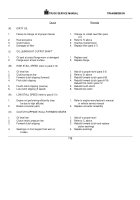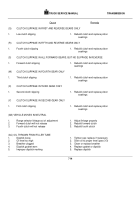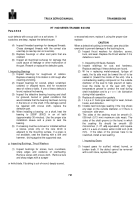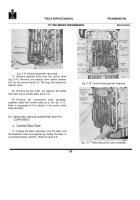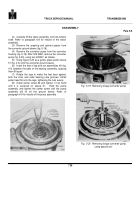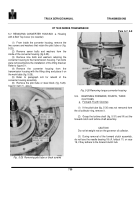TM-5-3805-254-14-P-2 - Page 728 of 894
TRUCK SERVICE MANUAL
TRANSMISSIONS
HT 700D SERIES TRANSM I SS IONS
Para 4-5/4-6
such defects with crocus cloth or a soft stone.
If
scratches are deep, replace the defective part.
(4) Inspect threaded openings for damaged threads.
Chase damaged threads with the correct size
used tap (a new tap can cut oversize).
(5) Replace housings or other cast parts that are
cracked.
(6) Inspect all machined surfaces for damage that
could cause oil leakage or other malfunction of
the part. Rework or replace the defective parts.
f. Inspecting Bearings
(1) Inspect bearings for roughness of rotation.
Replace a bearing if its rotation is still rough after
cleaning and oiling.
(2) Inspect bearings for scored, pitted, scratched,
cracked, or chipped races, and for excessive
wear of rollers or balls.
If one of these defects is
found, replace the bearing.
(3) Inspect the defective bearing housing and shaft
for grooved, burred or galled conditions that
would indicate that the bearing had been turning
in the bore or on the shaft. If the damage cannot
be repaired with crocus cloth, replace the
defective part.
(4) When installing a bearing
on a shaft, heat the
bearing to 2000F (930C) in an oil bath
(approximately 30 minutes). Use the proper size
installation sleeve and a press to seat the
bearing.
(5) If a bearing must be removed or installed without
a sleeve, press only on the race which is
adjacent to the mounting surface. If a press is
not available, seat the bearing with a drift and
hammer,
driving against the supported race.
g. Inspecting Bushings, Thrust Washers
(1) Inspect bushings for scores, burs, roundness,
sharp edges and evidence of overheating.
Remove scores with crocus cloth.
Remove burs
and sharp edges with a scraper
or knife blade. If bushing is out-of-round, deeply scored,
or excessively worn, replace it, using the proper size
replacer.
CAUTION
When a defective bushing is removed, care should be
exercised to prevent damage to the bushing bore.
(2) Inspect thrust washers for distortion, scores,
burs, and wear. Replace the thrust washer if it is
defective or worn.
h. Inspecting Oil Seals, Gaskets
(1) Inspect sealrings for cuts and hardness.
Replace sealrings if these defects are found.
(2) W he n replacing metal-encased, lip-type oil
seals, the lip side must be toward the oil to be
sealed in (toward the inside of the unit). Use a
nonhardening sealing compound on the outside
diameter of the seal to help prevent oil leaks.
Coat the inside lip of the seal with high-
temperature grease to protect the seal during
shaft installation and to p r o v i de lubrication
during initial operation.
(3) Replace all composition gaskets.
(4) I n s p e c t hook-type sealrings for wear, broken
hooks, and distortion.
(5) Installa new hook-type sealring if the ring shows
any wear on the outside diameter, or if there is
excessive
side wear.
(6) The sides of the sealring must be smooth (0.
005-inch (0.13 mm) maximum side wear). The
sides of the shaft groove (or the bore) in which
the sealring fits should be smooth (50
microinches (1. 27
u
m)
equivalent) and square
with t h e axis of rotation within 0.002 inch (0.05
mm).
If the sides of the grooves have to be
reworked, install a new sealring.
i. Inspecting Gears
(1) Inspect gears for scuffed, nicked, burred, or
broken teeth. If the defect cannot be removed
with a soft stone, replace the gear.
721
Back to Top



